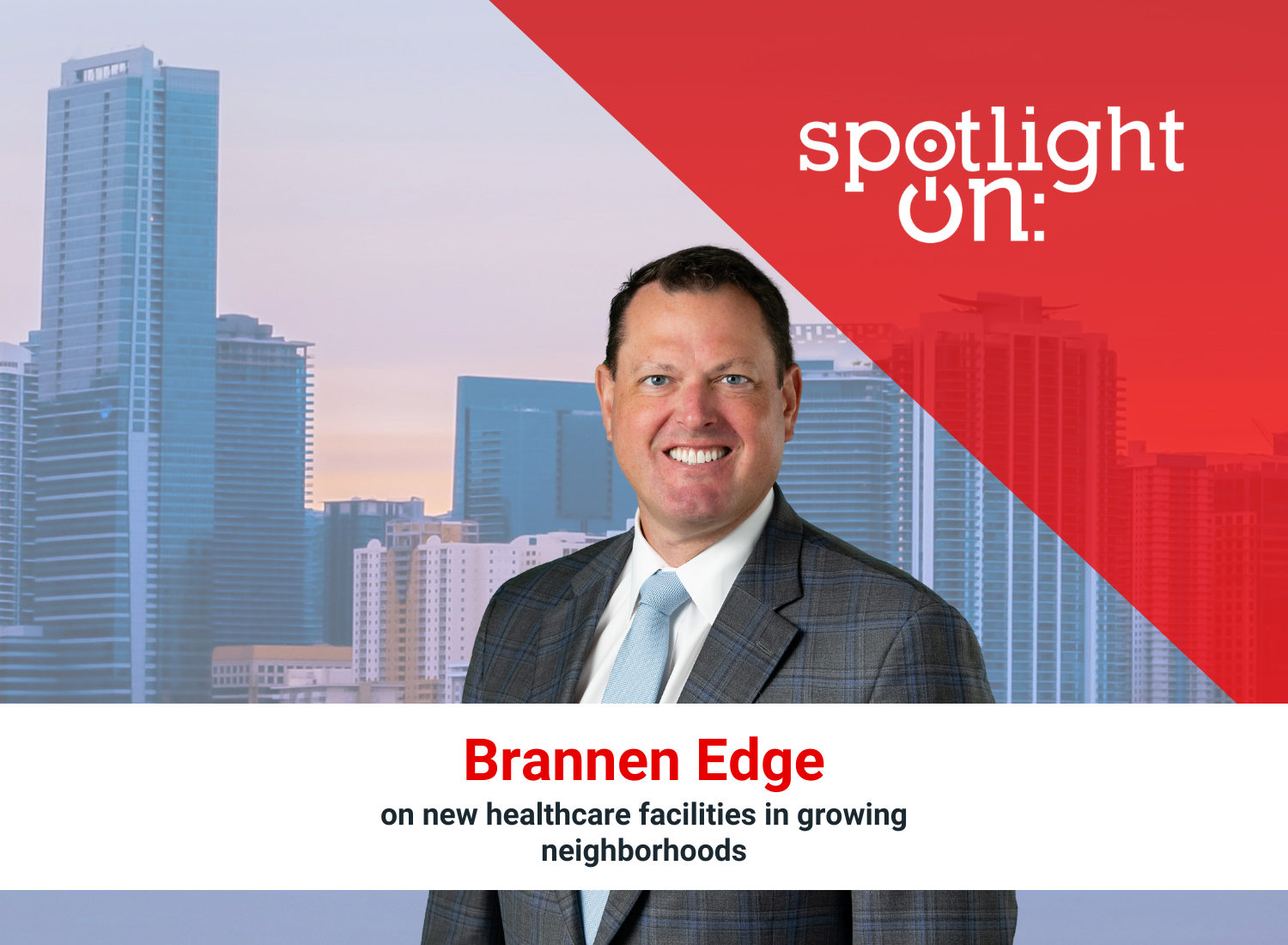Spotlight On: Brannen Edge, President & CEO, Flagship Healthcare Properties

June 2025 — In an interview with Invest:, Brannen Edge, president & CEO of Flagship Healthcare Properties, highlighted the company’s expansion in Tampa and Nashville, focusing on healthcare real estate in high-growth markets. He underscored Flagship’s role in optimizing healthcare facilities amid financial and operational pressures.
What’s been keeping Flagship Healthcare Properties busy over the past year, particularly in Tampa Bay and Nashville?
We are focused on growing our presence and investment in both markets. In Florida, we continue to focus on the rapidly growing Tampa-to-Orlando corridor. In Tampa specifically, we just wrapped up a ground-up development on West Fletcher in the Carrollwood area. What began as a speculative project is now anchored by Women’s Care, a leading national women’s health physician group, with the rest of the building nearly fully leased. Our Florida expansion started with building the right team—hiring professionals with deep healthcare real estate experience in Tampa. When entering a new market, we look for three key factors: strong healthcare fundamentals, key relationships, and an existing asset base. In Tampa, we had all three. We brought on experienced professionals, leveraged existing relationships, and expanded our asset base. Today, we own 12 buildings in Florida, representing about 11% of our operating income – a significant leap from where we began, with more growth ahead.
Nashville, on the other hand, feels like the healthcare center of the country. It’s home to major healthcare REITs, hospital systems, surgery center operators, and providers. We opened an office with just one person, and it’s now grown to a team of five and we’re outgrowing our space. Tennessee has become increasingly important to us, with seven properties generating about 6% of our net operating income. We’ve invested in multiple markets — Chattanooga, Knoxville, Memphis — and we’re preparing to buy another building in Chattanooga. Still, Nashville remains at the heart of healthcare, not just in Tennessee but nationally, and we plan to continue putting resources into that market.
Where are you seeing the most demand for healthcare facilities?
Health systems have recognized that their main hospital campuses are often overcrowded, and patients don’t always need to go there for routine care. As a result, they’re realizing they can achieve better outcomes, provide greater convenience, and lower costs by shifting services off-campus.
The largest growth area is ambulatory surgery centers (ASCs). These services are expanding rapidly, driven by changes in regulations and a growing demand for more efficient, cost-effective care. Many states are relaxing certificate-of-need requirements, which has made it easier to open new ASCs. At the same time, procedures that once required a hospital setting — such as full orthopedic joint replacements — are now being performed in outpatient settings under the Centers for Medicare and Medicaid Services (CMS) rules. However, these procedures require larger and more specialized spaces, which many existing buildings can’t accommodate.
We’re seeing strong demand for new healthcare facilities in growing neighborhoods where infrastructure has not kept pace. Many of these areas did not require healthcare facilities 10 or 20 years ago, but they do now. As older buildings aren’t available to repurpose, we are focusing on developing new, state-of-the-art outpatient centers to meet this increasing demand.
With the cooling office market, are you seeing opportunities to retrofit office buildings for healthcare use?
Conversions are often discussed, but they can present significant challenges. The biggest hurdle is parking — medical outpatient buildings need about five spaces per 1,000 square feet, sometimes more. Many office or retail buildings simply don’t have enough parking to accommodate this demand. Plumbing is another critical issue. In most office or retail spaces, plumbing is centralized, but in a medical building, each exam room usually requires its own plumbing. This can make retrofitting cost prohibitive. Additionally, floor plate size is a key consideration. Modern medical tenants often prefer spaces between 15,000 and 25,000 square feet, which many older office buildings are unable to provide.
That said, we’ve seen success when the right conditions align. For example, last September, we acquired a vacant call center in Wilmington, N.C., that was ideal for conversion. The building featured large, open floor plates (about 50,000 square feet), an abundance of parking (a necessity for call centers), and a layout that made plumbing installation feasible. Post-COVID, many call centers became obsolete, allowing us to acquire the building at a price that made economic sense for both us and our healthcare tenants. While only a small percentage of office buildings are suitable for conversion, we are actively pursuing these opportunities. Our vertically integrated platform — which includes development, leasing, brokerage, and property and construction management — gives us a distinct advantage in executing these complex projects efficiently.
How is Flagship navigating the financial pressures facing healthcare providers?
Healthcare systems have faced significant financial strain, a situation that has only worsened in recent years. The pandemic highlighted these issues, with staffing shortages and rising wages putting substantial pressure on margins. When you factor in the increasing cost of medical equipment, pharmaceuticals, and consolidations of physician groups, it’s clear that healthcare systems are dealing with major financial hurdles.
One way we assist is through sale-leaseback transactions. Similar to the approach banks took with their branches decades ago, health systems are realizing they don’t need to own all their real estate. While they may prefer to own their main hospital campuses, they don’t necessarily need to own 50 or 100 outpatient buildings. We can acquire these properties, lease them back, and allow health systems to redeploy capital where it’s needed most.
In addition to acquisitions, we offer real estate strategy consulting. Healthcare providers want to understand where their patients live and work, so they can expand in the most strategic locations. Others require assistance negotiating more favorable lease terms, while some simply need facility management support to ensure their properties are being operated efficiently. We provide a full suite of services to help them navigate these challenges. Ultimately, healthcare providers’ primary goal is delivering exceptional care, not managing real estate. Our role is to handle the real estate side, allowing them to focus on what they do best.
What role do educational institutions play in your markets, and how does Flagship collaborate with them?
Teaching hospitals and medical schools are crucial drivers of healthcare growth in markets like Nashville, Tampa Bay, and now Charlotte. They not only train the next generation of doctors and nurses but also attract research funding, drive innovation, and spur business investment. Charlotte, for example, is finally getting a medical school, which will be a game-changer for the region. A strong educational and research presence strengthens the entire healthcare ecosystem.
While we’re still in the early stages of developing deeper relationships with universities, we see tremendous potential for collaboration. Our role is to provide high-quality medical facilities that allow these institutions to grow. We don’t fix broken bones or deliver babies, but we create the spaces where life-changing care happens. By ensuring healthcare providers have the right environments, we’re playing our part in supporting the industry.
How is the current economic environment impacting your strategy for growth?
The higher interest rate environment over the last two and a half years has impacted our business. The cost of financing has risen, slowing capital deployment across commercial real estate. Investors need higher returns to justify taking on risk, which means pricing has adjusted accordingly. As a result, transaction volume has declined across the industry.
However, healthcare itself hasn’t slowed. Demand for medical services continues to rise, especially in high-growth markets like Tampa and Nashville. We’ve seen increasing demand for our services business — leasing, brokerage, and property management — as healthcare providers look to optimize their real estate strategies. While transactions have slowed, our portfolio fundamentals remain strong, and we remain focused on long-term growth. Healthcare real estate continues to be a resilient asset class, buoyed by favorable demographics and sustained demand. As economic conditions stabilize, we expect to see renewed investment activity.
For more information, please visit:













